|
 Secure Site
Secure Site
|
 |
Archive for the 'Well-being' Category
 meditation sunrise How to Meditate
One of the first things you want to do is decide on a place, time, and position for meditation. Ask yourself: What’s the besttime of day for me? What is my commitment level? Can I make a commitment to do it at this time, every day? Will it be for 10 minutes, 20 minutes? How long will I commit to this? Will it be 10 days, 30 days, 60 days?
Write down your answers and journal about it. Then mark your calendar and note how you felt on the days you meditated. Writing these things down will keep you more accountable and set you up for continued success.
Find the spot you’re going to meditate in, but make sure it’s not a spot that you watch television in, or do anything else. When you train your body to recognize that “this is where I meditate,” you are supporting your meditation with a physical habit that your body recognizes.
Also think of bells and smells. Find the things that make your space sacred, create an ambiance that signifies thatthis is your space for meditation. Ask yourself: Do I need sound? Do I need candles or incense? Start with what you’re attracted to and find those things that resonate with you.
Once you’ve found your place, be sure to sit with your head, neck, and spine in alignment. In this position, you minimize the stress level for your body because it doesn’t have to work as hard to maintain balance. This position also allows you to be open to relaxation and minimizes your chances of falling asleep.
Now that you’ve found the place and time to meditate, let’s talk about the nature of your mind. It has never been trained to meditate and it’s natural that it will try to rebel. St. Teresa of Ávela said the mind before meditation is like a wild horse. When you decide to meditate, the mind attempts to buck you off and do everything it possibly can to keep you from “breaking” it. If you stay on it until you break it, that horse (your mind in meditation) will do you a great service.
I’ve found the major roadblocksfor people who are just beginning a meditation practice tend to fall into two categories: those that think they need to be perfect at meditation and give up because they miss a day or two, or feel they should have the mind of a monk with no distractions after just a few attempts. Or there are those on the opposite end of the spectrum who are sporadic about their practice and wonder why the benefits haven’t shown themselves. So when you begin meditation, expect that your mind is going to be like an untrained horse.
I find it’s best to set yourself up for success by starting with a short, 10- minute meditation. Meditating can be overwhelming for those who start with 30-minute meditations (or more), because the wild, untrained horse of your mind can be bucking and challenging you the entire time. Ten minutesis enough for people to start training themselves for meditation and feeling a little bit of success—like it’s working.
Think of meditation like exercise: You wouldn’t expect yourself to go into a gym and lift 150 pounds on your first try. You have to start with 10 pounds first and train up to it. It’s the same with meditation, and the 10-minute mark seems to be a great starting point.
When you first start to meditate, your brain usually goes off in different directions: to your grocery list or reminding you that you need to stop at the gas station on the way home. It’s a typical reaction for the “critic” in you to say “Oh no, I’m not meditating! I knew I couldn’t do this.” Instead of giving up, bring yourself back to center by focusing on your breath. At this point, you’re already in the driver’s seat of consciousness or you wouldn’t have noticed that you were distracted. Each time you catch yourself drifting off and bring yourself back to center, you are developing a muscle in your mind. Just like any other muscle, it needs to be trained, and this muscle will benefit you in countless ways.
Once you are able to reach this meditative state, you become the master of your mind (instead of a slave to it) and are able to push away the clouds of your monkey mind.
adapted from Natural Solutions Magazine, by Jill Englund, April 2011
Use our unique “Zen Clock” which functions as a Yoga & Meditation Timer. It features a long-resonating acoustic chime that brings your meditation or yoga session to a gradual close, preserving the environment of stillness while also acting as an effective time signal. Our Yoga Timer & Clock can be programmed to chime at the end of the meditation or yoga session or periodically throughout the session as a kind of sonic yantra. The beauty and functionality of the Zen Clock/Timer makes it a meditation tool that can actually help you “make time” for meditation in your life. Bring yourself back to balance.
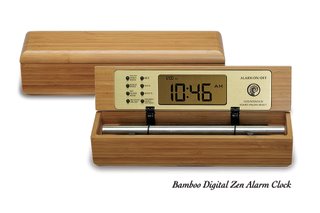 Meditation Timer with Chime -- The Zen Alarm Clock & Timer Now & Zen – The Meditation Timer Store
1638 Pearl Street
Boulder, CO 80302
(800) 779-6383
Posted in mindfulness practice, Well-being
 three meditation tips Establish your basic practice.
Make sure you have the essentials of your meditation practice clear in your mind. In general, this means establishing a basic sitting posture, training yourself to breathe comfortably, and witnessing your mind from an inner distance—either focusing on your breath or a mantra.
Add time in small increments.
Begin by sitting for 10 to 12 minutes on a regular basis. When you are ready, increase your sitting time to 15 minutes. Then, work your way up to 20 minutes. At that point, your meditation will be well established.
Don’t take on too much.
Ultimately, the length of your meditation will be determined by your mind’s capacity to concentrate. The key to sitting longer is to relax and deepen the process of concentration. From a practical point of view, when the mind becomes so tired of concentrating that you are no longer engaged in the process, the meditation is moving toward its end.
adapted from Yoga International by Rolf Sovik, May/June 2007
Use our unique “Zen Clock” which functions as a Yoga Timer. It features a long-resonating acoustic chime that brings your meditation or yoga session to a gradual close, preserving the environment of stillness while also acting as an effective time signal. Our Yoga Timer & Clock can be programmed to chime at the end of the meditation or yoga session or periodically throughout the session as a kind of sonic yantra. The beauty and functionality of the Zen Clock/Timer makes it a meditation tool that can actually help you “make time” for meditation in your life. Bring yourself back to balance
 Meditation Timers and Clocks with Chime in Bamboo, Walnut, Maple, and Black Lacquer Now & Zen – The Zen Timer Store
1638 Pearl Street
Boulder, CO 80302
(800) 779-6383
Posted in Meditation Timers, Meditation Tools, mindfulness practice, Well-being, Zen Timers
 tea time One of India’s most beloved pick-me-ups, chai (spiced milk mixed with black tea) is becoming a mainstay in yoga communities around the world. Why? According to ayurveda, its unique mix of ingredients makes it a healthy alternative to coffee or plain tea. The cardamom and milk balance out the stimulating effects of caffeine and the ginger helps you digest the milk and sugar. On high heat bring 1 cup of water and a 1⁄2 inch piece of fresh ginger (peeled and grated) to a boil. Then add:
1 tablespoon of black tea, 1 cup of milk, and 1⁄2 tablespoon of sugar. Bring this mixture to a boil, remove the pot from the stove, and add a pinch of cardamom. Cover and let sit for several minutes. Strain and enjoy.
Prep Tip: Speed up the process with two pots. Boil the milk and sugar in one pot, and the water, ginger, and black tea in another. Then combine and add the cardamom. (Don’t boil the ginger with the milk—that will cause your chai to curdle.)
Variations: For more exotic flavor, add a pinch of saffron with the sugar and a dash of rosewater with the cardamom, or a pinch each of cloves, cinnamon, and nutmeg with the ginger, or a dash of vanilla extract with the cardamom. For caffeine-free chai, substitute dandelion root, peppermint leaves, or lemon grass for black tea.
adapted from Yoga International by Crystal Ketterhagen, Spring 2010
“The Zen Alarm Clock & Chime Timer‘, uses soothing acoustic chimes that signal it’s time – gently and gradually.
Rather than an artificial recorded sound played through a speaker, the Zen Clock features an alloy chime bar similar to a wind chime. When the clock’s alarm is triggered, its chime produces a long-resonating, beautiful acoustic tone reminiscent of a temple gong.
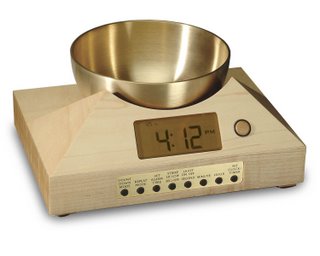 Tibetan Bowl Clock and Timer Now & Zen – The Zen Timer Store
1638 Pearl Street
Boulder, CO 80302
(800) 779-6383
Posted in Well-being, zen
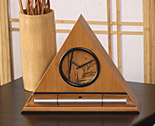 how to design a sacred space Create a personal meditation space that inspires your practice and invokes your higher self.
If you’re a gardener, you know the value of choosing an ideal site and preparing quality soil for nurturing healthy plants. The same is true for tending to your inner growth: when you devote a nook in your home to your practice and sow it with your higher intentions, you create the right conditions for your spiritual life to thrive.
A dedicated space collects and focuses your energy, removes uncertainty about where to practice, and, through habit and association, helps the mind move inward more quickly and deeply. Much like an encounter with the refrigerator conjures thoughts of food, and a glance at the couch invites a comfortable sprawl, catching sight of your meditation seat in a sanctified space will evoke your deepest yearnings and inspire you to do your practice.
Choose a place that can become a sanctuary—a quiet, private space protected from outside distractions and out of public view. You may be fortunate enough to designate an entire room, but a corner in your bedroom will suffice.
You’ll need a meditation seat—traditionally known as your asana—which may be a neatly folded blanket topped by a cushion for support, or even a chair or bench. Keep any additional props needed to support a comfortable sitting posture nearby, as well as your mala, shawl, or journal; but otherwise keep the space uncluttered and scrupulously clean.
A simple altar will serve as the heart of your space, calling you to your practice by providing inspiration and focus. An altar is an acknowledgement of the deeper essence of life and a bridge to the unseen—a link between our life in the world of elements and the subtle world. All altars, even public ones, serve to remind us of meaning and purpose in life, and connect us to inner strength and guidance. In religious or ritual settings, an altar is the locus for offerings made to ancestors or deities. In the context of yoga meditation, an altar inspires an offering of inner resources rather than outward ceremony or ritual, so simplicity is key.
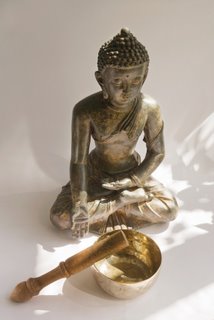 Carved Wooden Thai Buddha with Singing Bowl Try a small low table or a small chest of drawers at eye level, with a tasteful and simple covering. The objects you place upon your altar give focus, substance, and energy to your highest intentions. Traditionally, a flame (from a candle or a ghee lamp), water, flowers, fruit, and incense are offered on an altar to represent the gifts of the world given to us through the five elements. Often, these are joined by objects from a pilgrimage—a stone, sanctified water, or a sacred representation (such as a picture of Our Lady of Guadalupe or a carving of Lord Ganesha). The objects themselves are not as important as whether the altar uplifts the mind and touches the heart.
By creating a sacred space that encourages you to cultivate and nurture a devoted practice, you are one step closer to tasting the fruits of yoga—unconditional well-being and pure awareness.
adapted from Yoga International by, Sandra Anderson / co-author of Yoga: Mastering the Basics and has taught yoga and meditation for over 25 years.
Use our unique “Zen Clock” which functions as a Yoga & Meditation Timer. It features a long-resonating acoustic chime that brings your meditation or yoga session to a gradual close, preserving the environment of stillness while also acting as an effective time signal. Our Yoga Timer & Clock can be programmed to chime at the end of the meditation or yoga session or periodically throughout the session as a kind of sonic yantra. The beauty and functionality of the Zen Clock/Timer makes it a meditation tool that can actually help you “make time” for meditation in your life. Bring yourself back to balance.
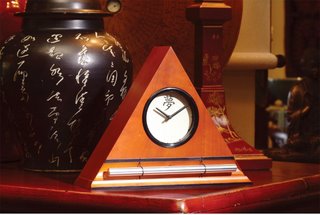 zen alarm clocks and chimes for a gentle awakening Now & Zen – The Zen Meditation Timer Store
1638 Pearl Street
Boulder, CO 80302
(800) 779-6383
Posted in Chime Alarm Clocks, Well-being, Zen Timers
 the link between sleeping and weight Not sleeping enough can do more than make you groggy the next day. It can also take a serious toll on your health—starting with your weight.
In the past several years, medical experts have confirmed a link between lack of sleep and weight problems, and a new study from the University of Chicago and the University of Wisconsin-Madison confirms this. Researchers conducted their study on two groups of overweight people. The first group slept for only five and a half hours each night, and the second group slept for eight and a half hours each night. The study found that while both groups lost weight, those who slept longer burned more fat, while those who slept less burned more muscle mass.
In an interview with NPR, sleep medicine expert Dr. Michael Lacey of the Atlanta Sleep Medicine Clinic explained that lack of sleep not only decreases metabolism, but also interferes with the body’s natural production of the hormones ghrelin and leptin, which regulate appetite and satiation. Too little sleep causes the body to produce too much ghrelin, which makes you feel hungry, and not enough leptin, which makes you feel satiated or full. Staying awake longer than you should will make you feel hungry when you’re really not, and will lead you to eat at times you normally wouldn’t. The longer you stay awake, the more tempted you’ll be to snack, too. To make matters worse, most people staying awake too long reach for high-carb or sugary foods, which they’re unlikely to burn off in the wee hours of the night.
Getting enough sleep will help your body burn fat and regulate weight. But how much is the right amount to get? Most sleep experts pinpoint seven to seven and a half hours as the magic sleep number. Sleep fewer than seven hours and you run the risk of fatigue and weight problems. Sleep too much and you put yourself at risk for cardiovascular disease.
adapted from Natural Home Magazine, October 2010 by Susan Melgren
 gentle alarm clock, for a slow wake-up
Now & Zen
1638 Pearl Street
Boulder, CO 80302
(800) 779-6383
Posted in Chime Alarm Clocks, sleep, Sleep Habits, wake up alarm clock, Well-being, Zen Alarm Clock
 meditation outdoors
- Find a park, forest, beach, nature preserve, or reservoir.
- If possible, remove your shoes. Walk around for a few minutes until you come to a place where you feel like pausing.
- Stand still for a moment and take in the natural elements around you. Take 10 deep breaths, inhaling through your nose and exhaling through your mouth.
- Notice how your body feels. What feels tight, tired, achy? What parts feel loose and easy? Take five more breaths, directing the breath to the tight places and relieving the tension as you exhale.
- Begin walking again, for as long as you’d like. Allow yourself to be completely absorbed by nature.
- When you are done, notice how you feel, such as whether your breath is easier, your body feels more relaxed, and your heart is more connected to what’s around you.
adapted from Body + Soul, January/February 2010
 meditation tools and timers with chimes
Now & Zen
1638 Pearl Street
Boulder, CO 80302
(800) 779-6383
Posted in Well-being
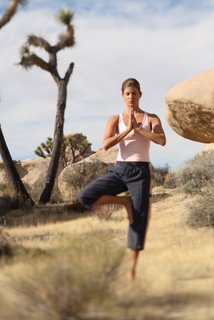 yoga “While yoga can certainly help you recover from injury, like any physical activity, it can also lead to one if you’re not careful. According to the U.S. Consumer Product Safety Commission, there were an estimated 5,000 reported injuries due to yoga practice in 2005. “Distinguishing pain from a really good stretch takes a little practice,” explains Baxter Bell, M.D., a Petaluma, California-based yoga teacher, physician, and medical acupuncturist. He offers these tips to reduce your risk of getting hurt.
1. Talk to your teacher before class. Your instructor can help you modify your poses to accommodate an injury, but only if he or she knows you have one. If your instructor doesn’t have good advice on how to approach your special need, consider looking for another instructor.
2. Don’t exceed your limits. Beginning students, especially, tend to push a little too hard.
3. Pay attention to hot spots. The knees, lower back, sacrum, wrists, and shoulders — observe all of these areas as you practice.
4. Use props. In a pose like Triangle, a block can help you come out of the depth of the pose.
5. Talk to your teacher after class. If something hurts as a result of your practice, let your teacher know so that the next class will be better.
6. Take post-practice care. Ice any sore spots or consider taking a natural anti-inflammatory.
adapted from Body + Soul, October 2007
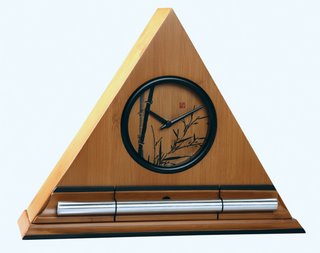 Zen Clock with Gentle Chime for Yoga and Meditation
Now & Zen
1638 Pearl Street
Boulder, CO 80302
(800) 779-6383
Posted in Well-being, yoga, Yoga Timer, Yoga Timers by Now & Zen
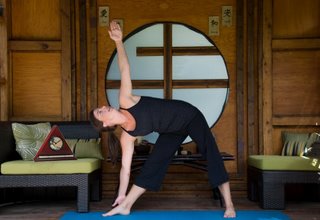 yoga tips from the masters New to yoga? Notable yoga experts offer these 5 tips.
1. “Along with your yoga mat and your towel, bring a sense of humor to class. Students who get hung up on doing everything ‘perfectly’ are less likely to come back.”
–Seane Corn, creator of the Vinyasa Flow Yoga DVD series and national yoga ambassador for YouthAIDS
2. “Don’t force your way into yoga. Adapt your movements to accommodate your level of strength and stamina, so that you avoid injury and feel comfortable in every pose.”
–Baron Baptiste, founder of Baptiste Power Vinyasa Yoga
3. “Watch out for what I call ‘self mutilation’ — spending your time talking to yourself about what you can’t do. This will make your practice dismal. The more you stay connected to feeling the pose — to breathing into the pose — the better your experience will be.”
–Ana Forrest, founder of Forrest Yoga
4. “To jump-start your practice, go on a yoga retreat. By temporarily shelving all the distractions in your normal life, you’ll learn enough in just two or three days to make a big difference in your weekly yoga class experience.”
–Richard Faulds, former president of Kripalu
5. “When you get to class, keep an open mind. Tune in to your own infinite possibilities. And drink water.”
–Guruatma Singh Khalsa, co-owner of Franklin Yoga and yoga instructor for 32 years
adapted from Body + Soul, by Abbie Barrett
Use our unique “Zen Clock” which functions as a Yoga Timer. It features a long-resonating acoustic chime that brings your meditation or yoga session to a gradual close, preserving the environment of stillness while also acting as an effective time signal. Our Yoga Timer & Clock can be programmed to chime at the end of the meditation or yoga session or periodically throughout the session as a kind of sonic yantra. The beauty and functionality of the Zen Clock/Timer makes it a meditation tool that can actually help you “make time” for meditation in your life. Bring yourself back to balance.
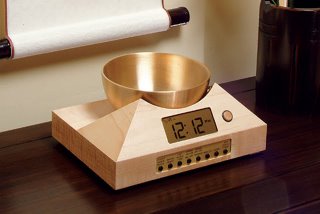 yoga tools for wellness Now & Zen – The Yoga Timer Store
1638 Pearl Street
Boulder, CO 80302
(800) 779-6383
Posted in Well-being, yoga, Yoga Timer
 meditating by mountain peaks, finding balance Myth: A balanced person is good at everything.
Truth: Balance requires prioritizing.
You might also recognize this as “superwoman syndrome”: the idea that you should be able to fill all needs, including your own, all the time. But life is not a pie chart. And because the world is not balanced, we should not expect to be either. This is where the 80/20 rule comes in. This established business principle posits that, by and large, roughly 80 percent of results come from 20 percent or fewer of the causes.
Think about what is most important for you to accomplish, and why. How can you make the most of your talent and energy in order to reach your goals? What is the benefit of focusing on these few things? Does it give you more time with your family, open up more opportunities, provide additional income? Weigh in with yourself about each action you want to take and why; that way you will be less likely to spread yourself too thin and sabotage your best efforts.
adapted from Body + Soul
Use our unique “Zen Clock” which functions as a Yoga & Meditation Timer. It features a long-resonating acoustic chime that brings your meditation or yoga session to a gradual close, preserving the environment of stillness while also acting as an effective time signal. Our Yoga Timer & Clock can be programmed to chime at the end of the meditation or yoga session or periodically throughout the session as a kind of sonic yantra. The beauty and functionality of the Zen Clock/Timer makes it a meditation tool that can actually help you “make time” for meditation in your life. Bring yourself back to balance.
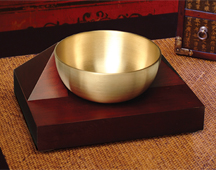 Singing Bowl Meditation Timer with Gradual Chime
Now & Zen – The Zen Alarm Clock & Timer Store
1638 Pearl Street
Boulder, CO 80302
(800) 779-6383
Posted in wake up alarm clock, Well-being
 finding balance Myth: You must be in control.
Truth: Real balance means being in flux.
At the circus, all eyes are on the tightrope walker. Why? Because where there’s balance, there’s also tension and risk. The tightrope walker’s talent and skill resides not in her ability to defy gravity, but in making the hundreds of subtle, incremental readjustments to account for imbalance. In the same way, our ability to achieve balance is in learning to reestablish it when forces put it to the test.
This is why stability alone is not balance. The more we cling to things (circumstances, people, possessions) to hold us in balance, the less we rely on our internal strength and flexibility to adapt. And because balance is not a fixed point, but always moving forward, we need to move forward, too. This can mean embracing change and allowing ourselves to evolve.
Moving to a new city, letting go of an old relationship, or losing a job are potential triggers for imbalance, and any one of them has the potential to throw you off your axis, causing stress, exhaustion, or anxiety. Balance comes when we adapt to change, rather than try to resist it. But you can start small: Encourage and practice smaller-scale changes in your life so that you’re better prepared to handle the bigger ones.
adapted from Body + Soul
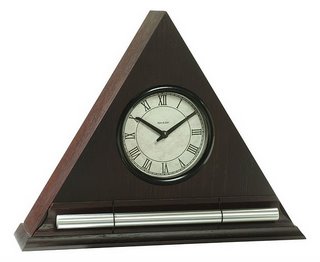 zen chime clocks, tools for well-being
Now & Zen
1638 Pearl Street
Boulder, CO 80302
(800) 779-6383
Posted in mindfulness practice, Well-being
« Previous Page — « Previous Entries
Next Entries » — Next Page »
|
|
|
|